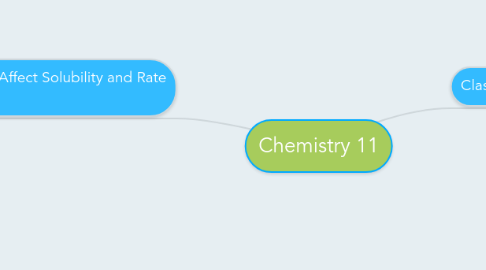
1. Factors That Affect Solubility and Rate of Dissolving
1.1. Solubility and Forces Between Particles
1.1.1. The formation of solutions depends on the relative strength of three categories of forces:
1.1.1.1. 1. Forces that attract particles of the solute to each other.
1.1.1.2. 2. Forces that attract particles of the solute to particles of the solvent.
1.1.1.3. 3. Forces that attract particles of the solvent to each other.
1.2. Solubility in Water
1.2.1. Hydrogen Bonding
1.2.1.1. -attraction between a hydrogen atom on one molecule and a very electronegative atom on another molecule
1.2.1.2. -type of dipole-dipole attraction between molecules
1.2.2. Solubility of Ionic Compounds in Water
1.2.2.1. -most ionic compounds soluble in water
1.2.2.2. -attraction between ions in a soluble ionic compound and the dipoles on water molecules is great enough to pull ions away from surface of ionic compound
1.2.2.3. Hydration
1.2.2.3.1. -process in which water molecules surround the molecules or ions of a solute
1.2.2.4. -attraction between ions in some ionic compounds is greater than attraction between ions and dipoles on water molecules
1.2.2.4.1. -these ionic compounds will not dissolve in water
1.2.2.5. -formula represents overall composition of solute
1.2.3. Solubility of Molecular Compounds in Water
1.2.3.1. -dipole-dipole attraction can occur between molecules of any polar compound
1.2.3.1.1. -attraction much weaker than attraction between ions in ionic compound
1.2.4. Solubility of Polar Compounds in Water
1.2.4.1. -most polar compounds dissolve in water
1.2.4.2. -dipole-dipole attraction between polar solute molecules much weaker than hydrogen bonds between solute and water molecules
1.2.4.3. -non-polar molecules do not dissolve in water
1.2.4.3.1. -these molecules only weakly attracted to water molecules
1.2.5. Conductivity of Aqueous Solutions
1.2.5.1. -conductivity tests indicate whether compound dissolved in water is ionic or molecular
1.2.5.1.1. Ionic
1.2.5.1.2. Molecular
1.2.6. Predicting Whether an Ionic Compound Is Soluble in Water
1.2.6.1. -when water dissolves solute, it must separate particles of solute
1.2.6.1.1. -when attraction between cations and anions is strong, they are harder to separate, which makes substance less soluble in water
1.2.7. Solubility Guidelines for Ionic Compounds
1.2.7.1. 1. Hydrogen, ammonium, and alkali metal ions form soluble compounds with most anions.
1.2.7.2. 2. Nitrate and acetate ions for soluble compounds with most cations.
1.2.7.3. 3. Chloride¸, bromide, and iodide ions form compounds that have low solubility with silver, lead(II), mercury(I), copper(I), and thallium cations only.
1.2.7.4. 4. Fluoride ion forms compounds that have low solubility with magnesium, calcium, barium, and lead(II) cations only.
1.2.7.5. 5. Sulfate ion forms compounds that have low solubility with calcium, strontium, barium and lead(II) cations only.
1.2.7.6. 6. Sulfide ion forms soluble compounds with hydrogen ions, ammonium ions, alkali metal ions and the group 2 cations.
1.2.7.7. 7. Hydroxide ion forms soluble compounds with hydrogen cations. ammonium cations, alkali metal cations and strontium, barium and thallium cations.
1.2.7.8. 8. Phosphate, carbonate, and sulfite ions form compounds that have low solubility with all cations except hydrogen, ammonium and alkali metal cations.
1.2.8. Predicting Whether a Molecular Compound Is Soluble in Water
1.2.8.1. -size of non-polar portion of molecule affects solubility
1.2.8.1.1. Smaller
1.2.8.1.2. Larger
1.3. ``Like Dissolves Like``
1.3.1. -when forces between the solute and solvent molecules are similar, the solute will dissolve in a solvent
1.4. Temperature and Solubility
1.4.1. -temperature increases, solubility increases
1.4.2. -temperature decreases, solubility decreases
1.4.3. Effect of Temperature on the Solubility of Liquids and Gases
1.4.3.1. -same temperature, no change in solubility
1.4.3.2. -solubility decreases with temperature increase, vice versa
1.4.4. Environmental Effects of Increased Temperatures
1.4.4.1. Global Warming
1.4.4.1.1. -gases in atmosphere become less soluble with temperature increase
1.5. Pressure and Solubility
1.5.1. -solubility of gas in a liquid is directly proportional to the pressure of that gas above the liquid
1.6. Factors That Affect the Rate of Dissolving
1.6.1. Rate of Dissolving
1.6.1.1. -measure of how quickly a solute dissolves in a solvent
1.6.2. Agitation or Mixing
1.6.2.1. -increases rate of dissolving by increasing number of collisions between solute particles and solvent particles
1.6.3. Temperature
1.6.3.1. -higher temperatures, increased kinetic energy
1.6.4. Surface Area
1.6.4.1. -increasing surface area of solute, increases amount of solute in contact with solvent
2. Classifying Solutions
2.1. Solution
2.1.1. -homogeneous mixture of two or more substances
2.2. Solvent
2.2.1. -component of a solution that is present in the greatest amount
2.3. Solute
2.3.1. -substance dissolved in a solvent
2.4. Aqueous Solution
2.4.1. -solution that contains water
2.5. Types of Solutions
2.5.1. Solid
2.5.1.1. Solid Dissolved in Solid
2.5.1.1.1. -structural steel made of carbon dissolved in iron
2.5.1.2. Liquid Dissolved in Solid
2.5.1.2.1. -wax made of liquid mineral spirits or liquid toluene dissolved in solid wax
2.5.1.3. Gas Dissolved in Solid
2.5.1.3.1. -ice contains dissolved air
2.5.2. Liquid
2.5.2.1. Solid Dissolved in Liquid
2.5.2.1.1. -seawater contains chloride ions, sodium ions and other solutes
2.5.2.2. Liquid Dissolved in Liquid
2.5.2.2.1. -antifreeze liquids mixed with water
2.5.2.3. Gas Dissolved in Liquid
2.5.2.3.1. -when carbonated beverage is opened, dissolved carbon dioxide bubbles out
2.5.3. Gas
2.5.3.1. Solid Dissolved in Gas
2.5.3.1.1. -molecules of naphthalene and paradichlorobenzene separate from mothballs to form a solution with air
2.5.3.2. Liquid Dissolved in Gas
2.5.3.2.1. -water dissolves in air
2.5.3.3. Gas Dissolved in Gas
2.5.3.3.1. -natural gas is a solution of methane and other gases
2.6. Solubility and Saturation
2.6.1. Solubility
2.6.1.1. -maximum amount of solute that will dissolve in a given quantity of solvent at a specific temperature
2.6.2. Saturated, Unsaturated, and Supersaturated Solutions
2.6.2.1. Saturated Solution
2.6.2.1.1. -solution that cannot dissolve more solute
2.6.2.2. Unsaturated Solution
2.6.2.2.1. -solution that could dissolve more solute
2.6.2.3. Supersaturated Solution
2.6.2.3.1. -solution that contains more dissolved solute than a saturated solution at the same temperature
2.6.2.3.2. -unstable solution
